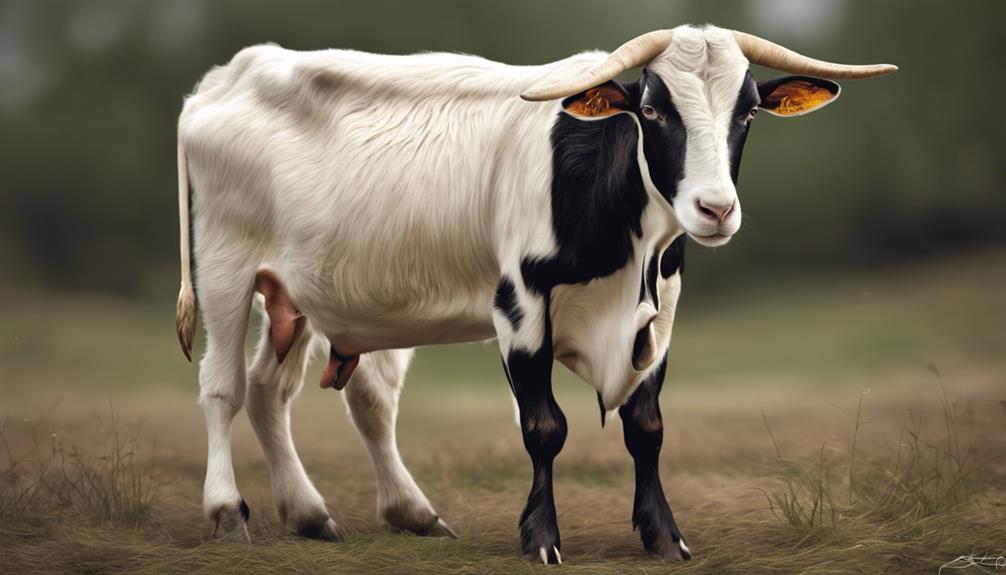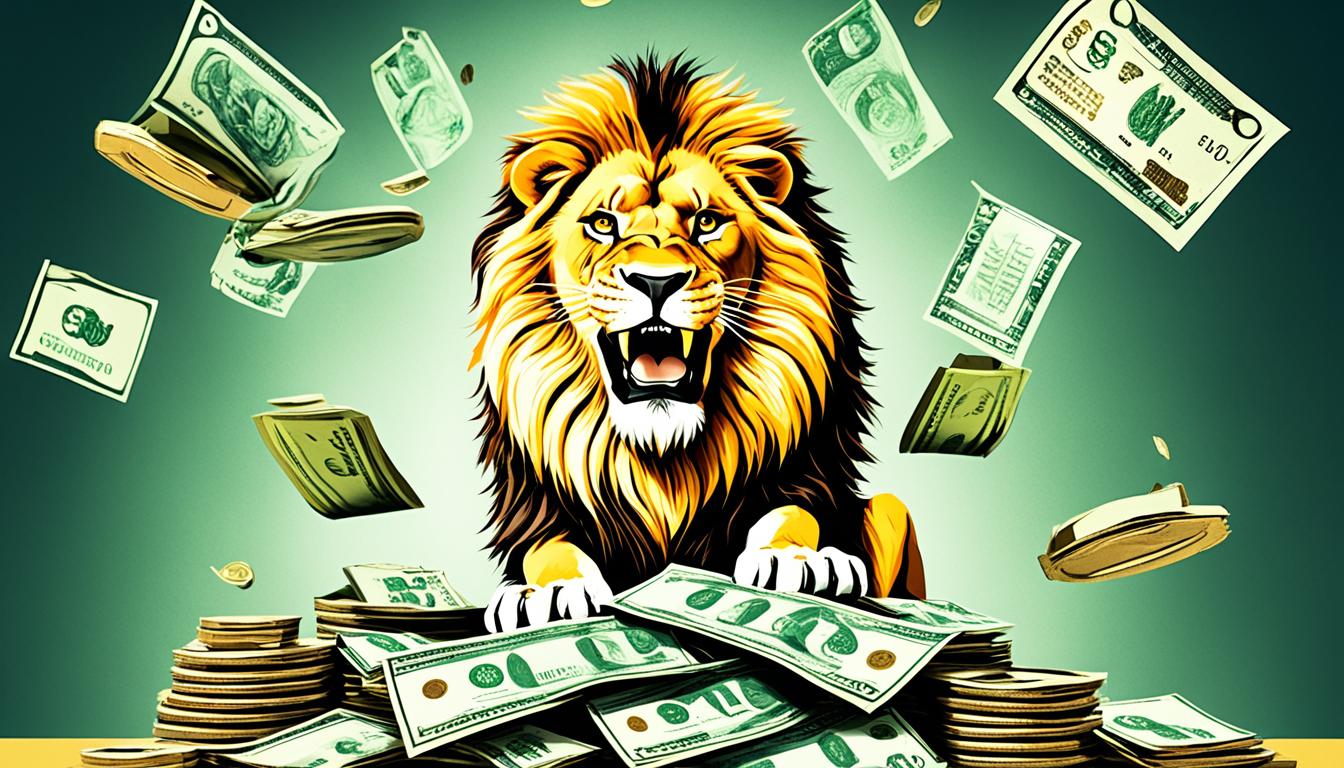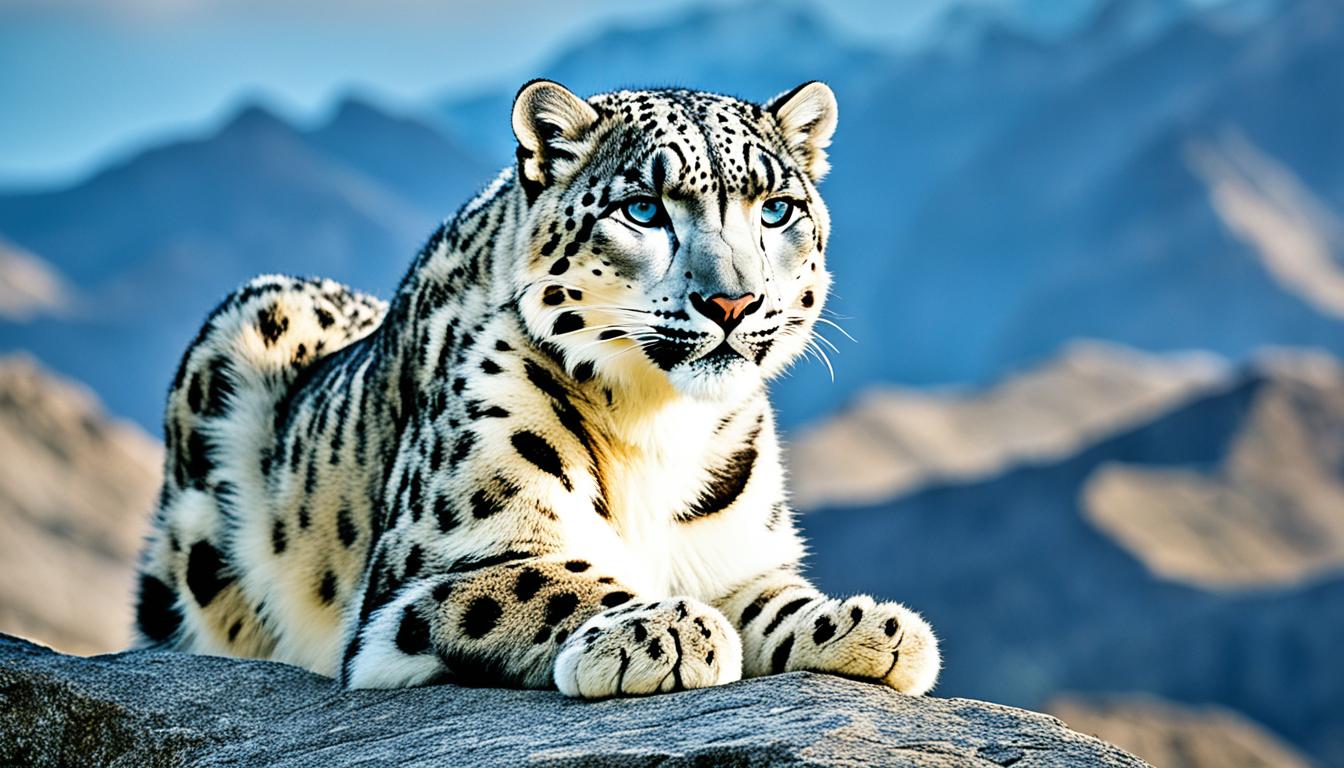Cows are big, up to 1,500 pounds, with broad bodies and large udders. Goats are smaller, around 100-200 pounds, with slim builds and small udders. Cows have longer, wider horns; goats may or may not have any. Goats sport long ears and a beard, unlike cows. Their milk differs in quantity and quality. Cows produce more milk but fat content varies. Both provide meat and milk, each with unique flavors and nutrients. Goats prefer different plants than cows, needing less food. Understanding these differences will help you make decisions about farming or caring for these animals.
Key Takeaways
- Cows are larger, weighing up to 1,500 pounds, while goats are smaller, weighing around 100-200 pounds.
- Cows generally produce more milk than goats, with different fat content and cream separator use.
- Cows provide beef and milk, while goats offer chevon and milk, each with unique nutritional profiles.
- Cows graze on grasses, while goats prefer woodier plants, requiring tailored feeding strategies for optimal health.
- Goats are curious and agile, while cows are more predictable and easier to handle, impacting care needs and handling.
Size and Physical Characteristics
When comparing cows and goats, one can immediately notice the stark differences in size and physical characteristics.
Cows are hefty animals, tipping the scales at up to 1,500 pounds, while goats are daintier, usually weighing around 100-200 pounds.
Regarding physical build, cows boast a sturdy frame with a broad body and large udders, whereas goats flaunt a slender physique with more petite udders. Horns also play a role in distinguishing the two; cows sport longer and broader horns, while goats may or may not have horns, depending on their breed.
Additionally, goats exude agility and nimbleness, sporting distinctive features like elongated ears and a beard, contrasting with the more placid and robust appearance of cows.
These variations in size and physical attributes impact how farmers handle, house, and feed these animals on the farm.
Milk Production and Quality
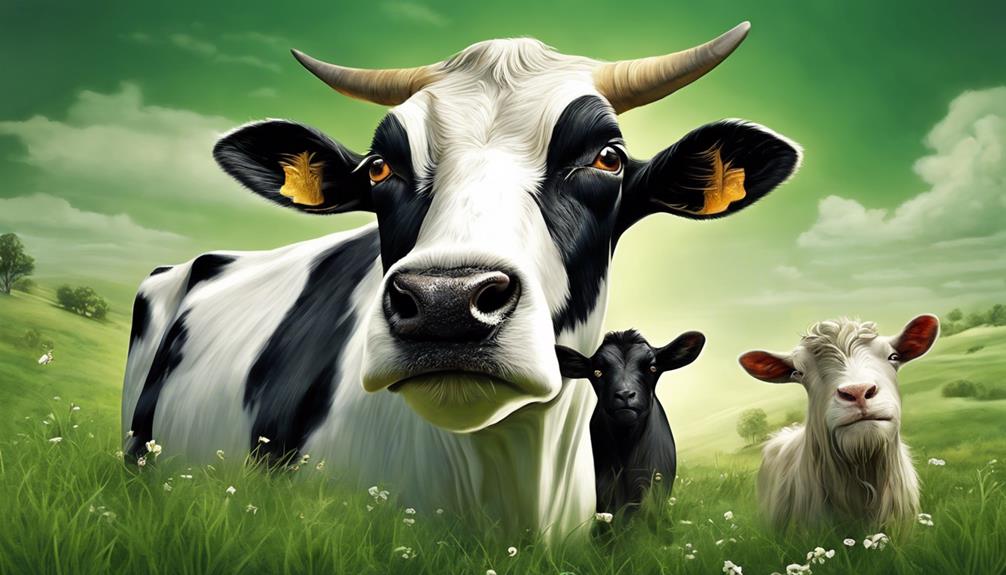
When comparing cows and goats for milk production, it's crucial to recognize that cows generally produce more milk than goats do.
Additionally, the fat content in milk from cows can differ from that of goats, impacting the taste and texture of the final product.
Understanding these differences can help in making informed decisions when it comes to choosing between cow and goat milk for consumption.
Milk Quantity Differences
Cows outperform goats in milk production, making them a preferred choice for those seeking larger quantities of milk. While goats are smaller and easier to handle, they can't match the milk output of a Jersey cow.
The use of a cream separator can help extract cream from cow's milk, but this is less common with goat milk due to lower fat content. Goat milk tastes can vary based on factors like the presence of a buck with does, hygiene during milking, and the animals' diet.
Understanding the milk production capacity of the animal or its dam is crucial before making a purchase decision. For those looking to yield substantial amounts of milk, cows are the way to go.
Milk Fat Content
Spotting differences between cows and goats extends to their milk fat content, impacting both production and quality. Nigerian Dwarf Goats offer milk with 6-10% fat, resulting in a rich and creamy texture suitable for various dairy products.
In contrast, Jersey cows typically provide milk with around 5% butterfat, offering a well-balanced richness. Saanen goats produce milk with approximately 3.5% milk fat content, ideal for different dairy items.
An interesting fact is that goat milk is naturally homogenized, unlike cow's milk, which can separate over time. If you leave cow's milk undisturbed, the cream rises to the top.
Understanding these differences in milk fat content between cows and goats can help in choosing the right type of milk for specific dairy needs.
Meat and Dairy Products
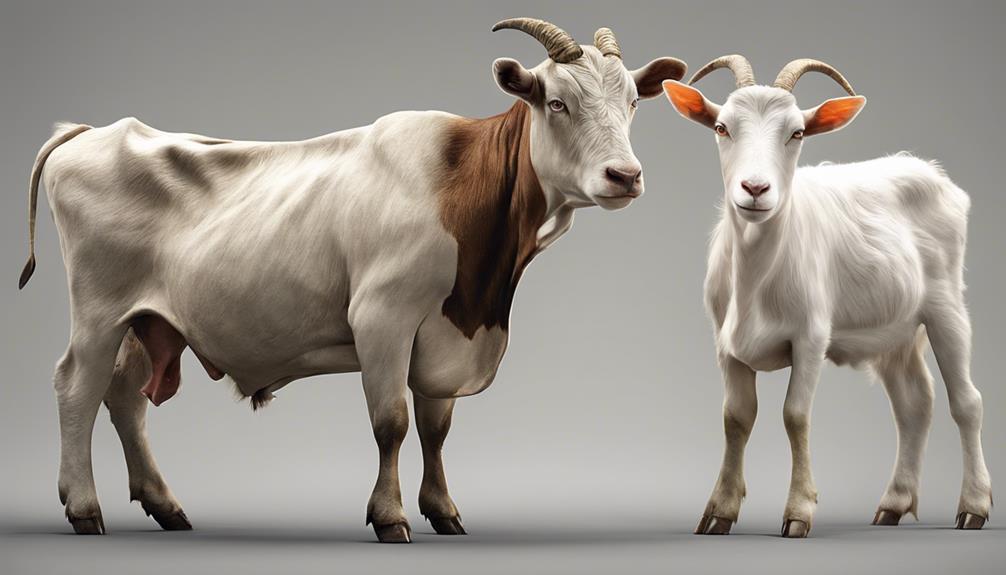
When it comes to meat and dairy products, cows provide beef and milk, while goats offer chevon and milk.
These two animals have distinct nutritional differences in the products they produce. Understanding these variations can help in making informed choices about what to consume.
Cows: Beef, Milk
Raising cows for beef and milk production is a common practice in agriculture. Cows provide essential products like beef and milk which are widely consumed. Cows are known for their high milk yield, making them valuable for dairy products such as milk, cheese, cream, butter, and yogurt.
Compared to goats, cows require more land for grazing and maintenance, typically about 2-3 acres per cow. This land requirement is essential to guarantee the cows have enough space to graze and roam freely. The beef from cows is a popular meat source globally, highlighting the significance of cows in providing both meat and dairy products for various purposes.
Goats: Chevon, Milk
In the domain of animal husbandry, goats stand out as versatile creatures that offer both chevon, a lean meat alternative, and nutrient-rich milk for consumption.
| Goat Breeds | Milk |
|---|---|
| Saanen | High in nutrients |
| Nubian | Creamy and flavorful |
| LaMancha | Naturally homogenized |
Goat milk, known for being easier to digest than cow's milk, is rich in nutrients like calcium and vitamins A and D. Goats, being dual-purpose animals, provide both meat (chevon) and dairy products. The milk from goats is often preferred by individuals with lactose intolerance due to its lower lactose content.
Nutritional Differences
As we shift our focus to the nutritional disparities between goat and cow meat and dairy products, it becomes evident that these differences play a significant role in dietary choices. Here are some key points to take into account:
- Goat meat is lower in fat and cholesterol compared to cow meat.
- Cow meat tends to be richer in flavor and juicier than goat meat.
- Goat milk is naturally homogenized, while cow milk is not.
- Cow milk contains more casein protein compared to goat milk.
- Goat milk is higher in calcium and vitamin A than cow milk.
These distinctions highlight the varying nutritional profiles of goat and cow products, offering consumers a range of options to suit their dietary preferences and health needs.
Feeding and Nutritional Needs
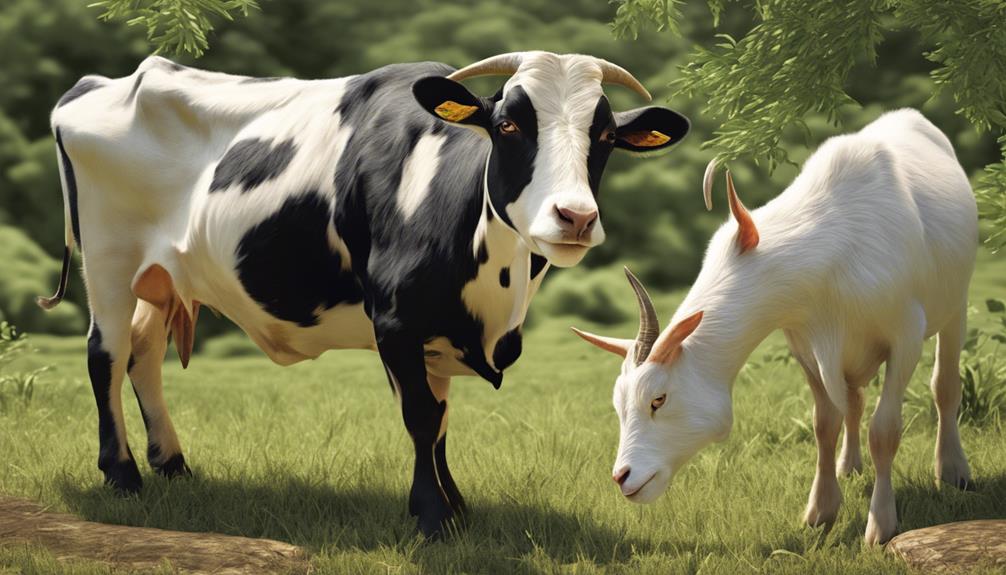
When considering the feeding and nutritional needs of cows and goats, it's essential to understand their distinct dietary preferences and requirements.
Cows, as grazers, have a penchant for grasses and forbs, while goats lean towards woodier plants and are adept at clearing brush. Due to their larger size and higher energy needs, cows necessitate larger feed quantities compared to goats.
Conversely, goats thrive on social interaction within herd dynamics, showcasing their efficiency in feed utilization despite their smaller size. Understanding these differences allows for tailored feeding strategies, ensuring peak health and productivity for both species.
It's fascinating how these nuances in dietary preferences and herd dynamics contribute to the varied milk production and overall well-being of cows and goats. By catering to their unique feeding habits and nutritional needs, one can harness the full potential of these animals in farming practices.
Behavior and Temperament
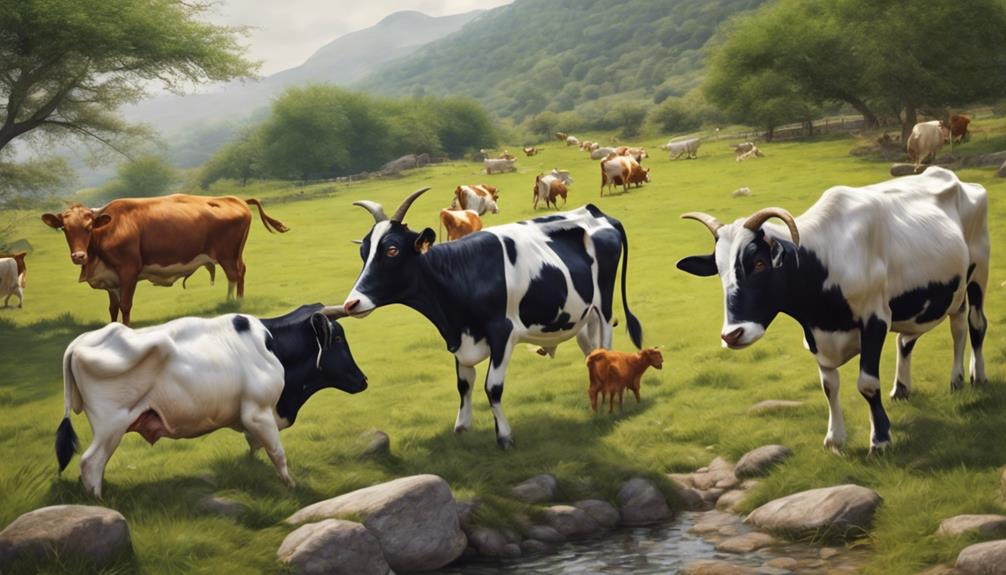
Cows and goats display distinct behavioral traits that highlight their unique temperaments and interactions within a farming environment. When it comes to behavior and temperament:
- Milking: Cows are often more accustomed to milking routines and handling, making the process smoother compared to goats.
- Escape: Goats are notorious for their curiosity and agility, making them more likely to attempt escaping enclosures than cows.
- Companionship: While cows can thrive independently, goats require companionship and do better when kept in pairs or groups for their well-being.
- Predictable: Cows are generally more predictable in their behavior, making them easier to handle and work with in a farming setting.
- Handling: Due to their docile nature, cows are typically easier to handle and manage compared to the more independent and sometimes stubborn goats.
Understanding these differences in behavior and temperament is essential for effective farming practices and ensuring the well-being of both cows and goats.
Space and Housing Requirements
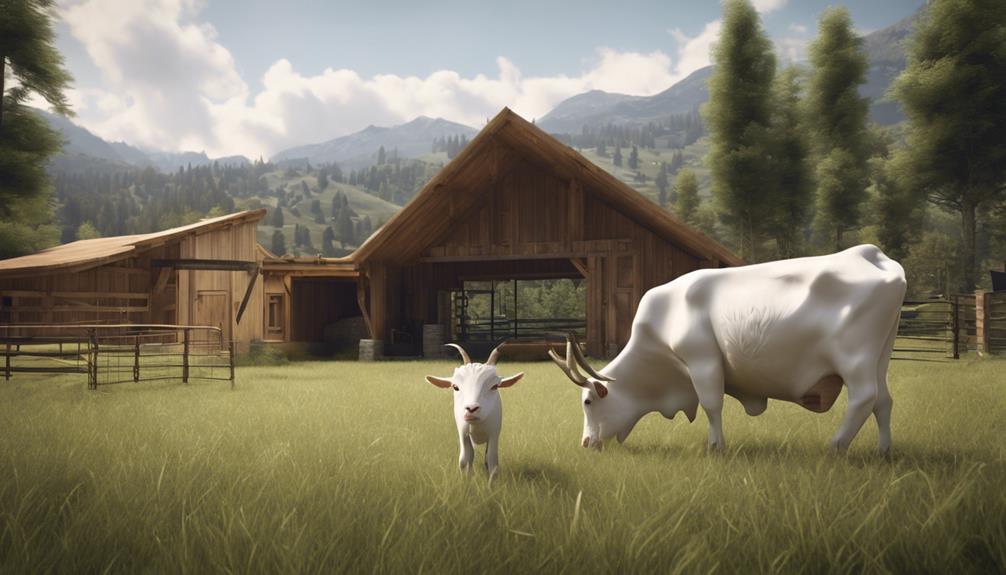
To effectively house both cows and goats, it's important to take into account their specific space requirements and housing needs.
While cows typically need 2-3 acres of land for grazing and housing, goats require considerably smaller areas, around 200-400 square feet per goat.
When it comes to housing, cows need sturdy fencing and a shelter to shield them from the elements, while goats, being more agile, may need secure fencing to prevent escapes. Proper ventilation is essential for both cow and goat housing to prevent respiratory issues.
Designing spaces for cows and goats that meet these requirements ensures their well-being and safety. Cows thrive in open areas with ample grazing land, whereas goats can adapt to smaller spaces more easily.
Understanding and meeting the space and housing needs of cows and goats are key steps in providing a suitable environment for these animals to live healthy and happy lives.
Health and Veterinary Care
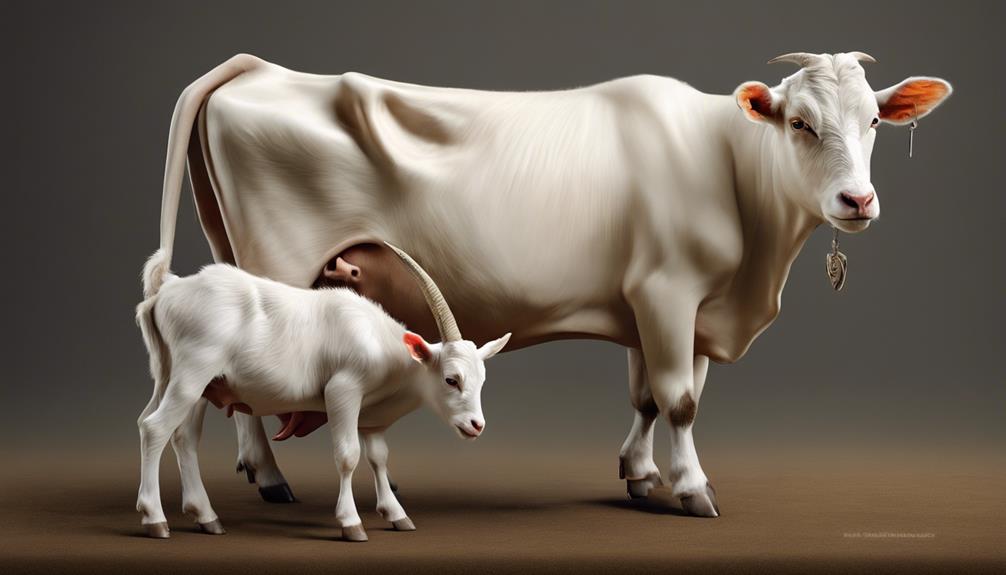
Regular veterinary care plays an essential role in maintaining the health and well-being of both cows and goats. When it comes to ensuring the best possible health of these animals, there are key differences to take into account:
- Cows require specific vaccinations to protect against common diseases.
- Goats need more frequent deworming due to their susceptibility to internal parasites.
Routine health checks are critical for both cows and goats to detect any health issues early on.
- Hoof trimming is necessary for maintaining the mobility and comfort of both cows and goats.
Understanding the distinct health needs and prevalent diseases of cows and goats is crucial for effective veterinary care.
Breeding and Reproduction
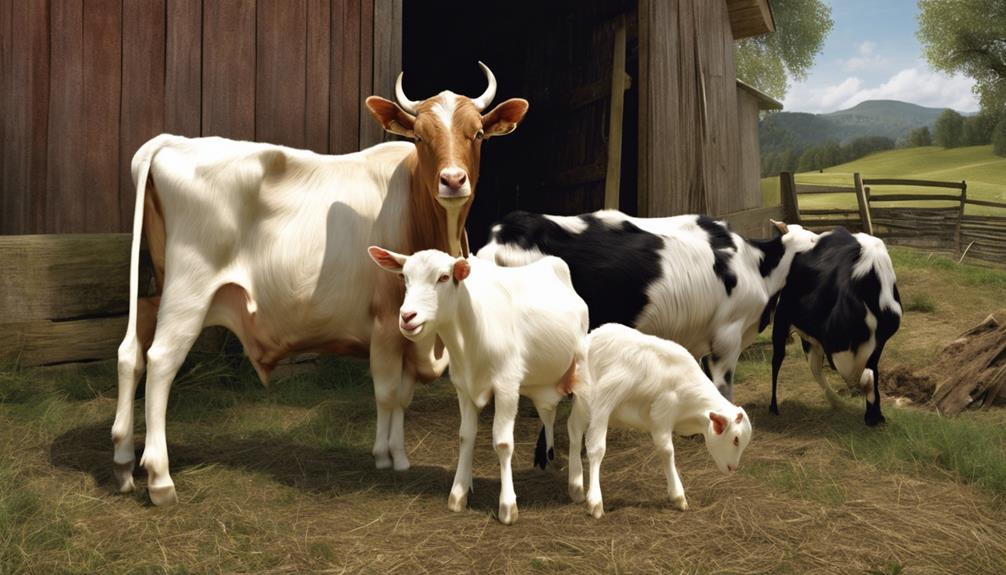
Breeding and reproduction play an essential role in the management of dairy animals, ensuring the continuity of healthy offspring and maximum milk production. When it comes to breeding animals, cows require the assistance of bulls, while goats need bucks for successful reproduction. Bucks and bulls are pivotal in the reproductive cycle, influencing the quality and quantity of milk produced by these animals.
Selecting the right breeding animals is key to guaranteeing healthy offspring and peak milk production levels. To maintain sustainable management practices, it's crucial to understand the intricacies of the breeding process in both cows and goats. By carefully managing the reproductive cycles of these animals, dairy farmers can guarantee the long-term success of their herds and the quality of the milk they produce.
Effective breeding practices not only contribute to the health and well-being of the animals but also play a significant role in the overall profitability of dairy farming operations.
Economic Considerations and Profitability
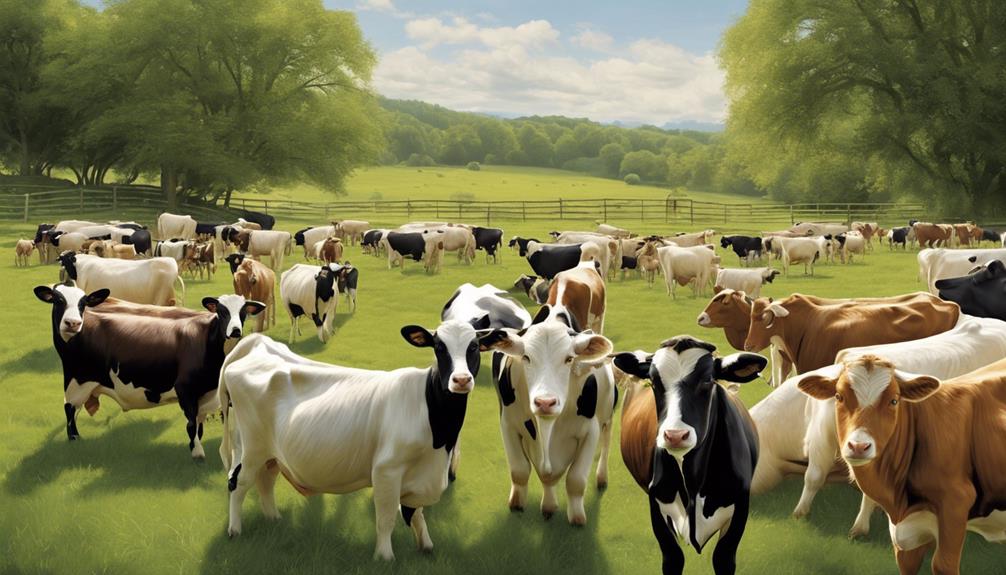
Considering the economic aspects of dairy farming, the profitability of choosing between cows and goats hinges on understanding their differing cost structures. When it comes to small-scale milk production, goats often prove to be more cost-effective due to their lower initial costs and maintenance expenses. Here are some key points to take into account for maximizing profitability:
- Lower Initial Costs: Goats generally require less investment upfront, making them a more accessible option for those starting in the dairy farming business.
- Easier to Keep: Goats are known for their adaptability and are generally easier to manage compared to cows, reducing the labor and resources needed for their upkeep.
- Maintenance Expenses: Cows tend to have higher ongoing costs related to feed and space requirements, which can impact the overall profitability of the operation.
- Financial Implications: Understanding the financial aspects of choosing between cows and goats is essential for making informed decisions that will positively impact the bottom line.
- Profitability: By carefully weighing the costs and benefits of each option, farmers can optimize their operations for maximum profitability in the dairy industry.
Frequently Asked Questions
What Are 2 Differences Between Goat's Milk and Cow's Milk?
When comparing goat's milk and cow's milk, two key differences are the fat content and lactose levels. Goat's milk has higher fat content, while cow's milk typically contains more lactose. These variations contribute to each milk's unique characteristics.
Are Goats Easier Than Cows?
Handling and milking goats is easier than cows. They are smaller, friendlier, and require less initial investment. Goats offer a more manageable and cost-effective option for beginners. Their simplicity and size make them a better choice.
Is It Easier to Milk a Cow or Goat?
Milking a goat feels like dancing in a gentle breeze, a harmonious symphony of udders and hands. It's an art form, a delicate balance of skill and connection. The simplicity and grace make it a joyous task.
What Are the Pros and Cons of Goats?
Managing goats presents several advantages. They are versatile, requiring minimal space. Their products vary from meat to wool. Goats' size makes them easy to handle. They are safe and less intimidating than cows, making them a practical choice.
Conclusion
To sum up, while cows and goats have many similarities, such as being domesticated farm animals used for milk and meat production, there are also key differences to take into account.
One common objection may be that cows are larger and require more space and resources than goats. However, it's important to remember that both animals have unique qualities and characteristics that make them valuable assets to any farm operation.
Understanding these differences can help farmers make informed decisions about raising either cows or goats.
